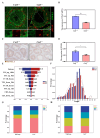CARF regulates the alternative splicing and piwi/piRNA complexes during mouse spermatogenesis through PABPC1
- PMID: 39696987
- PMCID: PMC12040762
- DOI: 10.3724/abbs.2024224
CARF regulates the alternative splicing and piwi/piRNA complexes during mouse spermatogenesis through PABPC1
Abstract
ADP-ribosylation factor collaborator (CARF), which is also known as CDKN2AIP, was first recognized as an ADP-ribosylation factor-interacting protein that participates in the activation of the ARF-p53-p21 (WAF1) signaling pathway under different conditions, such as oxidative and oncogenic stresses. The activation of this pathway often leads to cell growth arrest and apoptosis as well as senescence. Previous studies revealed that CARF, an RNA-binding protein, is critical for maintaining stem cell pluripotency and somatic differentiation. Nevertheless, its involvement in spermatogenesis has not been well examined. In this study, we show that male mice deficient in Carf expression present impaired spermatogenesis and fertility. IP-MS and RNA-seq analyses reveal that CARF/ Carf interacts with multiple key splicing factors, such as PABPC1, and directly targets 356 different types of mRNAs in spermatocytes. Carf-associated mRNAs display aberrant splicing patterns when Carf expression is deficient. In addition, our results demonstrate that PIWIL1 expression and localization are altered in the Carf -/ - mouse model through the downregulation of PABPC1, which further affects the ratio of pachytene-piRNA. Our study suggests that CARF is critical for regulating alternative splicing in mammalian spermatogenesis and determining infertility in male mice.
Keywords: CARF; PABPC1; alternative splicing; male infertility; spermatogenesis.
Conflict of interest statement
The authors declare that they have no conflict of interest.
Figures




Similar articles
-
Domain-functional analyses of PIWIL1 and PABPC1 indicate their synergistic roles in protein translation via 3'-UTRs of meiotic mRNAs.Biol Reprod. 2018 Oct 1;99(4):773-788. doi: 10.1093/biolre/ioy100. Biol Reprod. 2018. PMID: 29701755
-
Insights into the role of hnRNPK in spermatogenesis via the piRNA pathway.Sci Rep. 2025 Feb 22;15(1):6438. doi: 10.1038/s41598-025-91081-1. Sci Rep. 2025. PMID: 39987352 Free PMC article.
-
MIWI N-terminal RG motif promotes efficient pachytene piRNA production and spermatogenesis independent of LINE1 transposon silencing.PLoS Genet. 2023 Nov 13;19(11):e1011031. doi: 10.1371/journal.pgen.1011031. eCollection 2023 Nov. PLoS Genet. 2023. PMID: 37956204 Free PMC article.
-
The regulatory functions of piRNA/PIWI in spermatogenesis.Yi Chuan. 2017 Aug 20;39(8):683-691. doi: 10.16288/j.yczz.17-245. Yi Chuan. 2017. PMID: 28903896 Review.
-
piRNA and spermatogenesis in mice.Philos Trans R Soc Lond B Biol Sci. 2013 Jan 5;368(1609):20110338. doi: 10.1098/rstb.2011.0338. Philos Trans R Soc Lond B Biol Sci. 2013. PMID: 23166399 Free PMC article. Review.
References
-
- Chen L, Wang WJ, Liu Q, Wu YK, Wu YW, Jiang Y, Liao XQ, et al. NAT10-mediated N4-acetylcytidine modification is required for meiosis entry and progression in male germ cells. Nucleic Acids Res. . 2022;50:10896–10913. doi: 10.1093/nar/gkac594. - DOI - PMC - PubMed
-
- Mäkelä JA, Hobbs RM. Molecular regulation of spermatogonial stem cell renewal and differentiation. Reproduction. . 2019;158:R169–R187. doi: 10.1530/REP-18-0476. - DOI - PubMed
-
- Wang Z, Xu X, Li JL, Palmer C, Maric D, Dean J. Sertoli cell-only phenotype and scRNA-seq define PRAMEF12 as a factor essential for spermatogenesis in mice. Nat Commun. . 2019;10:5196. doi: 10.1038/s41467-019-13193-3. - DOI - PMC - PubMed
-
- Peart NJ, Johnson TA, Lee S, Sears MJ, Yang F, Quesnel-Vallières M, Feng H, et al. The germ cell-specific RNA binding protein RBM46 is essential for spermatogonial differentiation in mice. PLoS Genet. . 2022;18:e1010416. doi: 10.1371/journal.pgen.1010416. - DOI - PMC - PubMed
MeSH terms
Substances
LinkOut - more resources
Full Text Sources
Research Materials
Miscellaneous

